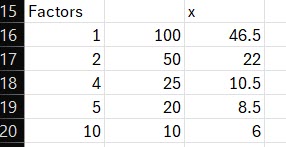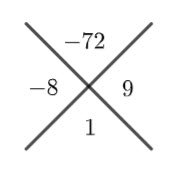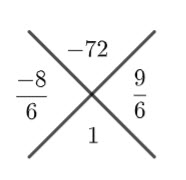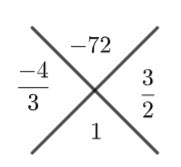Solve ![]() for
for ![]()
Remember the identity
(1) ![]()
Hence
![]()
Now I have
![]()
![]()
![]() or
or ![]()
![]()
![]() for
for ![]()
![]()
![]()
Hence ![]()
Solve ![]() for
for ![]()
Remember the identity
(1) ![]()
Hence
![]()
Now I have
![]()
![]()
![]() or
or ![]()
![]()
![]() for
for ![]()
![]()
![]()
Hence ![]()
Completing the square is useful to
When completing the square we take advantage of perfect squares. For example, ![]()
![]() and
and ![]()
Put ![]() into completed square form.
into completed square form.
What perfect square has an ![]() term?
term?
![]()
We don’t want ![]() , we want
, we want ![]() , so subtract
, so subtract ![]()
![]()
![]()
What about a non-monic quadratic? For example,
![]()
Factorise the ![]()
![]()
And continue as before
![]()
![]()
![]()
![]()
![]()
![]()
![]()
![]()
Find the value(s) of ![]() such that the equation below has two numerically equal but opposite sign solutions (e.g.
such that the equation below has two numerically equal but opposite sign solutions (e.g. ![]() and
and ![]() ).
).
![]()
![]()
![]()
![]()
![]()
For there to be two numerically equal but opposite sign solutions, the ![]() term of the quadratic equation must be
term of the quadratic equation must be ![]() .
.
![]()
Hence ![]() .
.
When ![]() the equation becomes
the equation becomes
![]()
![]()
![]()
![]()
![]()
![]()
Filed under Algebra, Polynomials, Quadratic, Quadratics, Solving, Solving, Solving Equations
Find exactly ![]()
We must be able to find an arithmetic combination of the exact values we knew to find ![]() .
.
![]()
![]()
I re-arranged as above, so I could take advantage of ![]() and
and ![]()
| Useful identities |
![]()
![]()
![]()
![]()
![]()
![]()
Hence,
![]()
![]()
![]()
Use the quadratic equation formula
![]()
![]()
![]()
![]()
![]()
As ![]() ,
, ![]()
Solve ![]() for
for ![]()
Sine is positive in the first and second quadrants.
![]()
![]()
But what if we aren’t given a domain for the ![]() values?
values?
Then we need to give general solutions.
For example,
Solve ![]()

As you can see from the sketch above, there are infinite solutions.
The sine function has a period of ![]() , and so if
, and so if ![]() is a solution then
is a solution then ![]() is also a solution. This means
is also a solution. This means ![]() is a general solution. And we can do the same for the second solution
is a general solution. And we can do the same for the second solution ![]() .
.
In general
We can turn this into one equation
What about cosine?
Solve ![]()

Cosine is positive in the first and fourth quadrants (it also has a period of ![]() . The first two (positive) solutions are
. The first two (positive) solutions are ![]() and
and ![]() .
.
To generalise, ![]() , which we can make into one equation
, which we can make into one equation ![]()
In general
What about the tangent function? Remember tan has a period of ![]() .
.
Solve ![]()

First, note that the solutions are all a common distance (![]() ) apart.
) apart.
Tan is positive in the first and the third quadrant
![]()
![]()
Because all of the solutions are ![]() radians apart, the general solution is
radians apart, the general solution is ![]()
In general
Solve for all values of ![]() ,
, ![]()
![]()
This is a quadratic equation – we need two numbers that add to ![]() and multiple to
and multiple to ![]() ,
, ![]()
![]()
![]()
![]()
Solve ![]()
![]()
![]()
![]()
![]()
![]()
![]()
Solve simultaneously
We could attempt to solve this simultaneously, but I think the algebra would be tricky.
The three equations are related to the roots of a cubic polynomial.
If the general equation of the polynomial is ![]() , then we know
, then we know
The sum of the roots
The product of the roots
and
So from our three equations we have
(1) ![]()
(2) ![]()
(3) ![]()
Let ![]() , then
, then ![]() , and
, and ![]()
Our cubic is ![]() and we can try to solve it.
and we can try to solve it.
The roots will be factors of ![]() , so
, so ![]()
Try ![]()
![]()
Hence ![]() is a root.
is a root.
Use synthetic division to find the quadratic factor
The quadratic factor is ![]() , which factorises to
, which factorises to ![]()
Hence the solutions are ![]() , and
, and ![]()
We could assume the solutions are natural numbers, then we can look at factors of 30.
| Factors of Thirty | ||
Hence the solutions are ![]() and
and ![]()
But with this approach we might not be able to find the solutions.
Find all of the positive integers that make the following expression a perfect square.
(1) ![]()
Let
![]()
where ![]() is an integer.
is an integer.
Expand and simplify
![]()
![]()
![]()
![]()
Factorise (using difference of perfect squares)
![]()
Find all of the factors of ![]()
![]()
First pair,
![]()
![]()
![]()
![]() must be an integer.
must be an integer.
I then used a spreadsheet

 values.
values.Hence the integers that make ![]() are perfect square are,
are perfect square are, ![]() and
and ![]() .
.
Let’s try another one,
![]()
(2) ![]()
![]()
![]()
![]()
Factors of 100,
![]()

So the possible integers are ![]() and
and ![]() .
.
Filed under Algebra, Arithmetic, Divisibility, Interesting Mathematics, Puzzles, Quadratic, Solving Equations
The general equation of a quadratic is ![]()
Let’s explore different methods of factorising a non-monic quadratic (the ![]() term is not
term is not ![]() )
)
Factorise ![]()
We need to find two numbers that add to ![]() and multiply to
and multiply to ![]() (i.e. add to
(i.e. add to ![]() and multiply to
and multiply to ![]()
The two numbers are ![]() and
and ![]()
This is the method I teach the most often
![]()
Split the middle term (the ![]() term) into the two numbers
term) into the two numbers
![]()
The order doesn’t matter.
Find a common factor for the first term terms, and then for the last two terms.
![]()
There is a common factor of ![]() , factor it out.
, factor it out.
![]()
![]()
Put ![]() into both factors and divide by
into both factors and divide by ![]()
![]()
Factorise
![]()
![]()
![]()
![]()
Multiply both sides of the equation by ![]()
![]()
![]()
![]()
Let ![]()
![]()
Factorise
![]()
Replace the ![]() with
with ![]()
![]()
![]()
![]()
![]()
![]()
Place the two numbers in the cross

Place the two numbers that add to ![]() and multiply to
and multiply to ![]() in the other parts of the cross.
in the other parts of the cross.

Divide these two numbers by ![]() (i.e
(i.e ![]() )
)

Simplify

Hence,
![]()
Which is
![]()
This is my least favourite method – although students get better with practice
![]()
The factors of ![]() are
are ![]() and
and ![]() and the factors of
and the factors of ![]() are
are ![]()
We know one number is positive and one number negative.
Which give us all of these possibilities
| Possible factorisations | ||
| No | ||
| No | ||
| No | ||
| No | ||
| No | ||
| Almost, switch the signs | ||
| Yes |
![]()
With a bit of practice you don’t need to check all of the possibilties, but I find students struggle with this method.
![]()
Create a grid like the one below
Find the two numbers that multiply to ![]() and add to
and add to ![]() and place them in the other grid spots (see below)
and place them in the other grid spots (see below)
Find the HCF (highest common factor) of each row and put in the first column.
Row ![]() HCF=
HCF=![]() , Row
, Row ![]() HCF=
HCF=![]()
For the columns, calculate what is required to multiple the HCF to get the table entry.
For example, what do you need to multiple ![]() and
and ![]() by to get
by to get ![]() and
and ![]() ? In this case it is
? In this case it is ![]() . It’s always going to be the same thing, so just use one value to calculate it,
. It’s always going to be the same thing, so just use one value to calculate it,
The factors are column ![]() and row
and row ![]()
![]()
The two methods I use the most are splitting the middle term, and the cross method, but I can see value in the grid method.
Filed under Algebra, Factorising, Factorising, Polynomials, Quadratic, Quadratics
My year 10 students have been learning how to complete the square with the idea of then deriving the quadratic equation formula.
The general equation for a quadratic is ![]()
Completing the square,
![]()
Factorise out the leading coefficient (i.e. ![]() )
)
![]()
Half the second term (i.e ![]() ) and subtract the square of the second term.
) and subtract the square of the second term.
![]()
![]()
Simplify
![]()
![]()
![]()
Now let’s solve
![]()
![]()
![]()
![]()
![]()
![]()
Which is the quadratic equation formula.
Filed under Algebra, Quadratic, Quadratics, Solving, Solving, Solving Equations